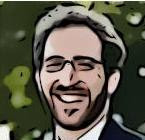The Results Are in: Take II
Thanks to BZ for sharing his initial thoughts on the recent "Emergent" community study.
I'll start by sharing two surprises.
Surprise 1: Lots of the Communities are in Places Other than NY or LA
Only 40% of communities in the study were in NY or CA. According to the 2006 Jewish Year Book about 2.8M of the US's 6.5M Jews (43%) live in NY or CA. The numbers don't quite match because the yearbook numbers aren't by city, but it is clear that the popular myth that independent minyanim only exist in NYC is unfounded.
Surprise 2: They Used the Phrase Had Romance With a Non-Jew.
More seriously, I found several aspects of the love life questions surprising.
2/3 have used Jewish Dating Services. Wow. It isn't clear whether they restricted this number to people who are actively dating, so a higher percentage of those dating may be using JDate and related programs. That's amazing. 2/3 of folks use these services. I wonder what implications this has for social networking sites like the kind Mobius has been envisioning. Clearly there is a demand and it is way bigger than I thought.
While I am on the Romance section of the survey check this out:
Dated only Jews in the Past Year:
IndyMinyans: 76%
Rabbi-Led Emergents: 59%
Alt Emergents: 71%
ACBP Syn. Members: 32%
"Had Romance with a Non-Jew"
IndyM: 58%
Rabbi-Led Emer: 78%
Alt Emer: 79%
ACBP Syn. Members: 59%
I have to assume that the romance with a non-jew numbers are lifetime stats otherwise there would be an astounding rather than very high rate of date jewish, schtup non-jewish. I have a nearly Clintonian level of interest in knowing what precisely "Had Romance with a Non-Jew" means.
It seems that folks are, at least in part, joining our communities to find love. I wonder how finding it impacts their invovlement. Speaking very personally, I remain as involved in TLS as i was while single and imagine that many others have as well. In fact, my partner has joined the community and i imagine others have brought dear friends and lovers into the scene. The old joke used to say that Goldberg comes to shul to talk to God and that Cohen comes to shul to talk to Goldberg. That dynamic seems alive and well and strengthened by Stein who comes to talk and or date Goldberg or Cohen and may end up talking to God.
Lastly, it isn't surprising that once the study restricted responses to unaffiliated groups it then shows high rates of movement from children of affiliated synagogues to young adults who eschew those labels.
Were i designing the study i think I'd have studied spiritual communities on the basis of more important structural similarities like urban/suburban/exurban population, self-rated degree of political or social justice themes in services, and figured out some method for evaluating lay-orientation and involvement in prayer.
For instance, a neat new spiritual community has started in West Philadelphia. A neighborhood better known for its Fresh Prince tie-in than Jewish community, Kol Tzedek was started by a progressive young committed core of folks. It now meets more frequently and has been blessed with impressive growth. i davened there for Kol Nidre and found it very meaningful. Why is that more or less emergent/cool than Ikar in LA. The main difference is that Kol Tzedek is Reconstructionist Affiliated (to their credit) and Ikar is not affiliated with any movement.
I am not quite sure why they laid out the restrictions they did. Founded after 1996. Why 1996? Why include Rabbi-led emergents. Why exclude similar affiliated groups? It seems like these choices were made strategically but not particularly transparently.
In conclusion, like BZ, I want to thank the folks studying this set of communities, say that I am eager to see the community-level data and that the future results are eagerly anticipated. I am especially curious to see the information on how folks get into the communities, how involvement has changed over time, domestic political beliefs, and religious/theological/ideological approaches of those in the study.


1 Comments:
Just FYI, Kol Tzedek not only is in the study but also helped promote it (see the appendices on the survey website), and Rabbi Lauren Grabelle Herrmann is a member of S3K’s Emergent Sacred Communities Working Group (see the S3K website). The report explicitly states (p.17, I think) that while most rabbi-leds are not affiliated, there are a few that are. And there’s no bar on emergent communities calling themselves “synagogues,” though, again, few do.
As we believe the study demonstrates, the emergent phenomenon as a whole has common “family resemblances” that transcend the details of organizational/leadership structure — but the point of “family resemblances” is that there are always cases of communities that don’t exhibit every single characteristic on the list but nonetheless clearly are more “emergent” than not. As a Reconstructionist synagogue, Kol Tzedek might appear on one level not to be emergent, but you are right to point out that it is no less emergent than IKAR.
Post a Comment
Subscribe to Post Comments [Atom]
<< Home